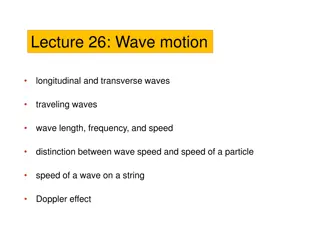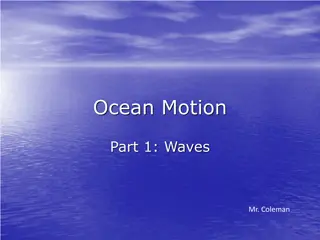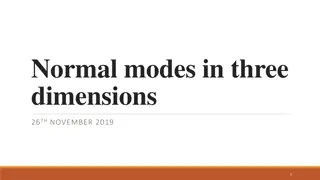Understanding Waves: Classifying and Exploring Wave Properties
Delve into the world of waves with lessons on wave classification, essential questions, and understanding the basics of waves as disturbances that transmit energy through mediums. Explore mechanical wave types and enhance your knowledge through practical labs and quizzes.
Download Presentation

Please find below an Image/Link to download the presentation.
The content on the website is provided AS IS for your information and personal use only. It may not be sold, licensed, or shared on other websites without obtaining consent from the author. Download presentation by click this link. If you encounter any issues during the download, it is possible that the publisher has removed the file from their server.
E N D
Presentation Transcript
AP Schedule PCR Waves Lesson 1 (all) and 2 a,b Lab, PLQ Finish PCR Standing Waves Lab Quest Quiz
Waves https://www.youtube.com/watch?v=g9oOT FXx7ck
Essential Questions: What do you already know about waves? What knowledge of waves is important?
Essential Questions: How do waves get classified? What features of a wave must be defined? What can we measure? What can we calculate / predict?
Lets start with What is a wave?
What is a WAVE? A disturbance (vibration) that travels through a medium A wave transmits ENERGY not the medium
Where should we start? How do we classify waves?
What is a wave? How do we classify waves? Read the Physics Classroom (PCR) SKIM Waves: Lesson 1 a-c (5 min or less) Record the most important info on white board (10-15 min) AFTER notes are complete, use the check your understanding (CYU) questions on pages b and c to determine if your notes cover the basic info (10-15 min)
Do you remember? Contrast mechanical waves with electromagnetic waves. What is a medium? Give an example. Name two categories of mechanical waves. Give an example of each.
Types of Mechanical Waves Transverse: the medium oscillates perpendicular to the propagation of the wave Longitudinal: the medium oscillates parallel to the propagation of the wave (ex: sound) Surface: the medium oscillates in a circle this is a combination of the other two types of waves
Whats next? What are the (anatomical) features of waves? What can we measure?
What are the features and measures? Read the Physics Classroom (PCR) Waves: Lesson 2 a&b (5-10min) Record information about wave FEATURES in notes (5-10 min) Create a Word Web for the three NEW MEASUREMENTS (already have Period) AFTER notes are complete, use the check your understanding (CYU) questions on pages a and b to determine if your notes cover the basic info (10-15 min)
Wave Features medium: material that transports a mechanical wave crest: top (of a _____________wave) trough: bottom (of a ___________wave) compression: medium is dense (____________wave) rarefaction: medium has low density (_________wave)
Wave Measurements wavelength: the distance from crest to crest (m) T period: the duration for a complete wave to pass a fixed position (s) f frequency: how many waves pass a given point each second (Hz) A Amplitude: the distance from the equilibrium position to a crest or trough
the distance from crest to crest or trough to trough No formula to define wavelength SI unit: meter (m) alternate units: cm, feet
Waves and ENERGY Waves transmit energy. Which measurement is most closely linked to the amount of energy the wave transmits?
PHET Simulation If you are finished the assignment early, you will benefit by: Googling PhET Going to Physics Simulations Choosing Sound & Waves Selecting Wave Interference Using the first tab (Water) to investigate what affects the wave measurements
What is the mathematical relationship between the
What is the mathematical relationship between the amplitude (m) of a wave and the energy (J) it transmits? energy (J) in a wave and its amplitude (m)?
Energy vs Amplitude What is the relationship?
Conclusion For a wave, the _____ is(______)proportional to the __________ (__________)as shown by the equation:_______________ This means if the _________ is ___________ then the ____________ will ___________. For example
Conclusion For a wave, the energy delivered is proportional to the amplitude squared as shown by the equation: energy = 977.5 (amplitude)2 This means if the amplitude of a wave is doubled then the energy it delivers will quadruple. For example, if the waves today in OC are 1.0m tall, and yesterday they were 2.0m tall, then they delivered 4x the energy yesterday than today.
Does this guy comprehend the relationship? (And what it means about the energy he is facing?)
These guys are enjoying the relationship!
Can you use the proportionality? On a nice summer day, the waves at the beach have an amplitude of 0.5m. On another, stormy day, the waves have an amplitude of 2.0m. Compare the energy delivered to the beach from individual waves on these two days.
Whats next? Or, what else do we need to know about waves? Or, are there any other relationships?
What are the relationships between wavelength (m)and frequency (Hz) wavelength (m) and amplitude (m) frequency (Hz) and amplitude (m) for a wave on a string?
What is the relationship between wavelength (m) and frequency (Hz) for a wave on a string?
Conclusions For a wave, the _____ is______proportional to the __________ as shown by the equation:____________________ This means if the _________ is ___________ then the ____________ will ___________. (use: double, triple, quadruple, halve, quarter, etc) For example
Quizzes, Quiz on Lessons 1 and 2a&b PLQ Read Waves, Lesson 2 d&e Create a WW for the new measurement Try some of the CYU on each page. How did you do?
Read PCR Read Waves, Lesson 2 d&e Create a WW for the new measurement
Wave Equations T = t / # of waves (by definition) f = # of waves / t (by definition) Frequency is the inverse of period f = 1/T = S / f Wave Speed = (frequency)(wavelength) S = f (from the lab) Speed = distance/duration (by definition, but also, from the lab) S = d/ t
Wave Problems A person sits on a dock, and observes waves passing. In 10 seconds, 5 waves pass, and while they pass, the surface of the water moves up and down a total distance of 0.50m. The crests are 1.0m apart. Determine the: A) period B) frequency C) amplitude D) wavelength E) wave speed F) duration to go 1609m
Practice Assignment Complete as many CYU as needed from PCR Lessons 2d&e (until you have achieved mastery of all equations) You know you have achieved mastery if you can complete the WS without your notes or a partner Mastery will be assessed on a quiz next week.
Practice Problem A student rhythmically slaps the water in the South swimming pool, striking the water 2 times each second. Each wave she generates reaches the far end of the pool (20m away from her) 26.7 seconds after it is generated. Determine the wavelength of the waves she generates. Be sure to show all five steps to solving word problems (a picture might help)
How do you know it is a wave? It will do each of these .
Wave Phenomena Reflection Interference Refraction Diffraction Doppler Effect
Read PCR Waves Lesson 3 to Find definitions and examples of : Reflection Interference Refraction Diffraction Doppler Effect
Reflection When a wave strikes a barrier and is deflected off of the barrier (always at the same angle) http://www.youtube.com/watch?v=0o6eyxtxB 2s
Interference Occurs when to waves that are traveling meet. Individual pulses add together when they are in the same location, and then continue on their way Constructive Interference: crest meets crest, or trough meets trough results in larger amplitude at that spot Destructive Interference: crest meets trough results in smaller (perhaps even ZERO) amplitude at that spot http://www.youtube.com/watch?v=5PmnaPvAvQY&NR= 1 http://www.youtube.com/watch?v=P_rK66GFeI4
Refraction Refraction is the name of the phenomenon where a change of the medium causes a change of the wave s ___________, which causes a wave to bend, or change direction. http://www.youtube.com/watch?v=stdi6XJX6 gU&feature=related
Diffraction Diffraction is the phenomenon that occurs when a wave passes through a narrow opening in a barrier, or passes the end of a barrier. http://www.youtube.com/watch?v=4EDr2YY9l yA&feature=related
Doppler Effect http://www.youtube.com/watch?v=Y5KaeCZ_AaY https://www.youtube.com/watch?v=I1ykNQijOC8 http://www.youtube.com/watch?v=- Zu5SGllmwc&feature=related
Waves Lesson 4 Skim: Determine your learning objectives Re-read to achieve these learning objectives Record notes that include explanations, examples and diagrams Predict what you can do with your new learning























